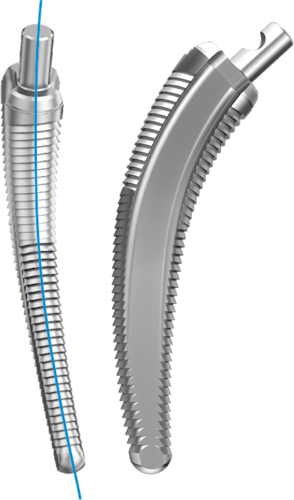C.F.P. II Hip System


LINK is one of the pioneers of anatomical and neck preserving prosthesis designs and has decades of experience in the development of these stem types.
The C.F.P.* stem which was introduced in 1998, has since then strongly marked the further development in the world of short stems. Today we are looking back at an impressive track record with survival rates of up to 98,3 % after 11 years.1
In the C.F.P. II stem this legacy continues by taking clinically proven design features and combining them with today’s requirements of a modern short stem.
The specific implant and instrument design conserves bone and soft tissue and adapts to the natural anatomy of the femur.2 Therefore the C.F.P. II equally lives up to its name and embodies our anatomical principles of bone preservation and “anatomy defines shape”.
The system is accompanied by a compact, ergonomic instrument set, which enables the surgeon to perform the arthroplasty smoothly and efficiently, regardless of the favored surgical approach.
* Collum Femoris Preserving

Anatomical Implant Design
The anatomical shape adapts to the natural femoral anatomy and effectively reduces stress risers.4, 5, 6

Polished and flattened neck
for higher ROM and less wear.

Ribbed profile for excellent primary
and secondary stability
The clinically proven ribbed structure serves to anchor the stem in the compressed cancellous bone and provides high primary and secondary stability.4, 9, 10

Tapered, rounded distal tip
The distal stem section facilitates implantation while also reducing the incidence of thigh pain, which can be caused by intramedullary fixation of a hip implant.11, 12

LINK HX (CaP) coating
The osteoconductive surface promotes bone ongrowth.7
LINK HX (CaP) Coating -
Surface Technology for Long Term Fixation
The HX-Coating is an osteoconductive CaP coating, approximately 15 μm thick which is applied in an electrochemical process. Due to the ultra-thin and highly soluble HX overcoat, the porous cell structure of the underlying substrate is retained open. This promotes osteoconduction and allows a stable osseointegration for secondary stability.7


Anatomical Compressor Design
Anatomically shaped stems require anatomically shaped instruments. The compressors of the C.F.P. II system strictly follow the anatomical stem design.

High fixation zones
Concave AP cross section for maximum bone preservation and engagement of the proximal ribs.

Press-fit
The compressors and implants are matched to provide optimal press-fit.

Terrace profile of the compressors
The C.F.P. II stem is anchored in a bed of compacted cancellous bone. The teeth of the compressors ensure that the cancellous substance is firmly compacted.3, 8

Rounded distal tip
Safe guidance and to avoid via falsa.
- Kendoff D, Citak M, Egidy CC, O'Loughlin PF, Gehrke T. (2013). Eleven-year results of the anatomic coated CFP stem in primary total hip arthroplasty. Journal of Arthroplasty, 28(6), pp. 1047-51.
- Vidalain, J. P., et al. (2011). The Corail Hip System. A practical approach based on 25 years of experience. Springer Heidelberg. pp. 54.
- Pipino, F., Keller, A. (2006). Tissue-sparing surgery: 25 years’ experience with femoral neck preserving hip arthroplasty. Journal of Orthopaedics and Traumatology, 7(1), pp. 36-41.
- Langhans, M., Hofman, D., Ecke, H., & Nietert, M. (1992). Der Einfluß der Formgebung des Prothesenschaftes auf die Beanspruchung des proximalen Femurs. Unfallchirurgie, 18(5), pp. 266-273.
- Noble, P., Alexander, J., Lindahl, L., Yew, D., Granberry, W., & Tullos, H. (1988). The anatomic basis of femoral component design. Clinical Orthopaedics and Related Research (235), pp. 148-165.
- Denaro, V., & Fornasier, V. (2000). Fill, fit and conformation - an anatomical and morphometric study of a hip component in total hip arthroplasty (Rippen-Link). European Journal of Orthopaedic Surgery & Traumatology, 10(4), pp. 239-247.
- Palm, L., Jacobsson, S., & Ivarsson, I. (2002). Hydroxyapatite coating improves 8- to 10-year performance of the link RS cementless femoral stem. The Journal of Arthroplasty, 17(2), pp. 172-175.
- DiGiovanni, C.W., Garvin, K.L., Pellicci, P.M. (1999). Femoral preparation in cemented total hip arthroplasty: reaming or broaching? Journal of the American Academy of Orthopaedic Surgeons, 7(6), pp.349-357.
- Schill S, Thabe H. (2000). Long- and Mid-Term Results of the Cementless Link Prosthetic System in Combination with the Ribbed Stem and Screw-in Cup, Type “V”. Orthopädische Praxis, 36, pp. 160-167.
- Thabe H, Wolfram U, Schill S. (1993). Medium-term results using the cement-free link endoprosthesis. Ribbed shaft V socket. Zeitschrift fur Orthopädie und ihre Grenzgebiete, 131(6), pp. 568-573.
- Petrou, G., Gavras, M., Diamantopoulos, M., Kapetsis, T., Kremmydas, N., & Kouzoupis, A. (1994). Uncemented total hip replacements and thigh pain. Archives of Orthopaedic and Trauma Surgery, 113(6), pp. 322-326.
- Khanuja, H., Vakil, J., Goddard, M., & Mont, M. (2011). Cementless femoral fixation in total hip arthroplasty.
The Journal of Bone & Joint Surgery, 93(5), pp. 500-509.














